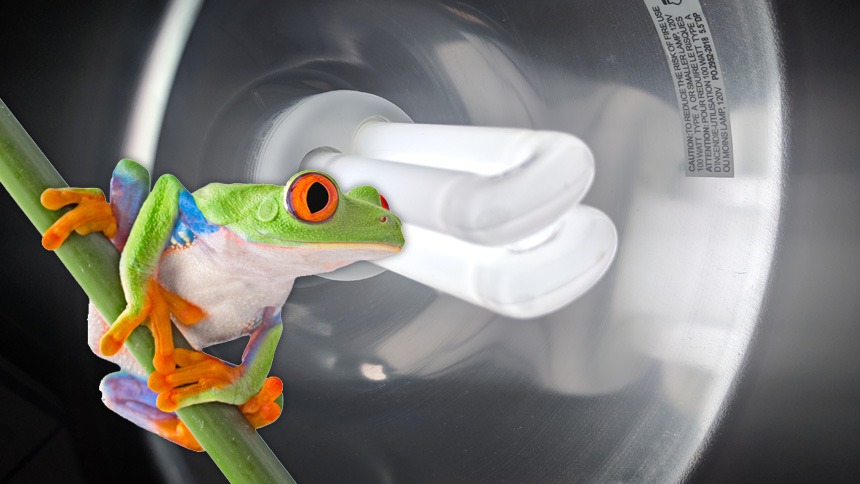
UVB Lighting For Frogs: Do They Need It?
Lighting for amphibians is a subject I’ve been meaning to cover for a while. It’s one of those topics that many people disagree about. Most of the disagreement is about nocturnal species and whether or not they actually need UVB; some sources say they do while others believe they don’t. I’ll do my best to explain both sides but most importantly, I’ll try to present the correct information in a way that’s easy to understand.
I usually try to give you, the reader, a short, precise answer at the beginning of a page (in case you don’t have time to read the whole thing). “An answer to what”, you ask? Well, on this page, I’ll be answering the question “Do frogs need UVB light?” Unfortunately, this isn’t an easy topic to summarize in a short answer. Regardless, I’ll do my best to keep my short answer short and to-the-point.
The short answer is this; frogs benefit from UVB light whether they’re a nocturnal species or not. Even the small amount of UVB that pierces through a jungle canopy can prove beneficial in boosting Vitamin D3 in reptiles and amphibians. So long as the correct bulb is used and your frogs have places to escape direct light, I recommend it. A 2.0 UVB bulb above their enclosure is great. Position plants and branches strategically to give your frog a place to hide from direct light.
Now you’ve read the short answer, I encourage you to check out the rest of the page. I’ll explain why UVB is beneficial to reptiles and amphibians and go into greater detail about the different types of bulbs and light fixtures. Finally, at the end of the page, I’ll tell you what setup I’m using for my Red-Eyed Tree Frog enclosure.
Page Contents
UVB: How It Benefits Reptiles & Amphibians
UVB or “UV-B” is ultraviolet light with wavelengths between the 290 – 320 nanometer range. When reptiles and amphibians are exposed to UVB, it allows them to product Vitamin D3. This also helps with the calcium they need in order to have strong bones. Different species require different amounts of exposure; some need to bask in the sun while others can absorb enough UVB in a short amounts of time.
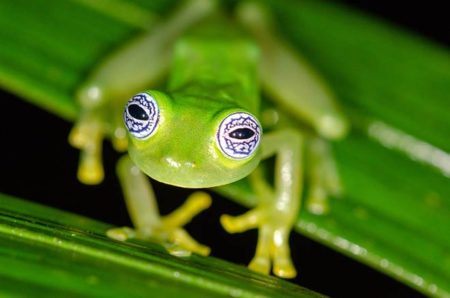
Where the confusion and disagreement starts is when you begin discussing nocturnal species. This isn’t unique to frogs, by the way. The same disagreement persists for certain lizard species too. The argument is that because nocturnal species hide and sleep during the day, they don’t require UVB lighting at all.
You have to factor in their natural habitat as well. Many of these nocturnal species live in thick jungles where direct sunlight is blocked by numerous trees and plants. Then there are burrowing frogs like Pacman frog and Tomato frogs; they spend much of their time burrowed under the substrate. Suffice to say, these species aren’t receiving very much UVB at all.
This is why there is confusion on whether or not to provide a UVB light for these species in captivity. But the argument can be made that, if they were in their natural habitat, they would be exposed to UVB from the sun, even if it’s just a small amount. And that small amount of UVB plays a role in keeping the frog healthy.
Natural Habitat vs Captive Habitat
Most people keep exotic frogs as pets because they genuinely like the species and enjoy watching them. For me, not only do I like the frogs themselves but I also enjoy naturalistic setups with live plants and cool looking branches too. It’s the whole package – not just the frog.
Whether you’re into bioactive terrariums or not, one of the main goals of a herpetologist is to recreate the natural habitat of the inhabitant as best as possible. From the type of food your pet eats to the temperature and humidity, it’s all important in the well-being of your pet frog.
Lighting and UVB, in my opinion, fall into this category. Yes, even for nocturnal frogs. If they were in their natural environment out in the wild, they would be exposed to some UVB, even though it’s not much.
I didn’t always recommend low-powered UVB lights for amphibians. Truth be told, my Red-Eyed Tree Frogs have gone most of their lives without a UVB light and they’re as healthy as the day I got them. Granted, I feed them gut-loaded crickets dusted with calcium and vitamin supplements but they’re in good shape. The reason I mentioned that is because I don’t want you to think you need to rush out and buy a UVB light right now.
UVB Bulbs & Domes
Whether you’re preparing an enclosure for new frogs or you’re wanting to add UVB to your current setup, this section is for you. I’ll talk about the common types of bulbs, what the numbers indicate, and how long you can expect them to last.
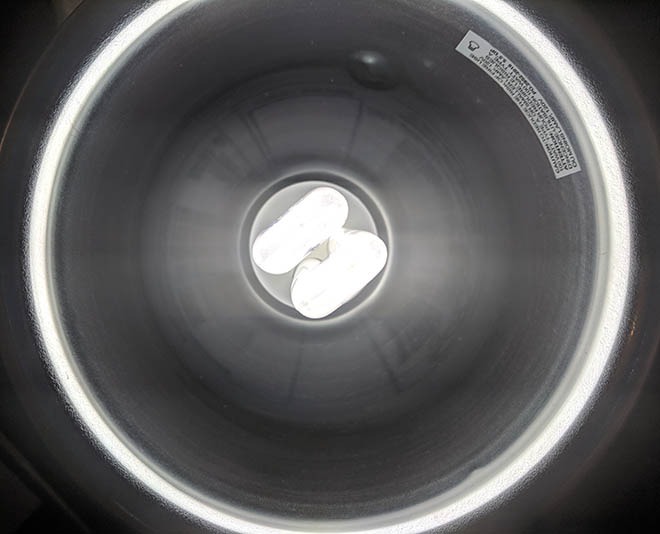
Bulbs
UVB bulb in the US market come in 2.0, 5.0, and 10.0. For those of you in the UK, I believe your market offers 6.0, 12.0, 14.0 and something similar in comparison to 2.0. The UVB 10.0 bulbs are mostly used for lizards that enjoy basking in the sun
For most frogs, a UVB 2.0 light bulb works well, so long as you provide them with a few places to escape from the light. You can do this by strategically placing branches, plants, and decorations in such a way that creates shaded hiding spots.
Now that you’re up to speed on this part, let’s take a look at the different kinds of lights. There are Fluorescent bulbs, Mercury Vapor bulbs, and Metal Halide bulbs. For each type of bulb, there is generally a corresponding “hood” or “dome” fixture in which you plug the bulb into.
Domes & Hoods
Hoods and domes are light fixtures – its where you screw in the light bulb. Dome’s typically have a reflective coating on the inside which is supposed to increase the effectiveness of the light. Hoods are more visually appealing and fit nicely on top of your terrarium. Some brands, like Exo Terra, sell hoods designed specifically for their enclosures.
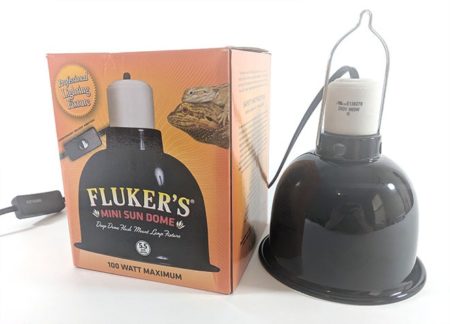
Degradation & Blocking UVB
UVB bulbs degrade over time which means they gradually stop emitting UVB (even though they’re still producing light). For this reason, you’ll need to replace the bulbs. The list below shows about how long you can expect each type of light bulb to last.
- Fluorescent bulbs typically last 6 months.
- Mercury vapor bulbs can last up to 1 year.
- Metal Halide bulbs sometimes last up to 2 years.
One way to know whether or not your UVB bulb(s) are producing enough UVB to by using a UV Index Meter. Solarmeter is a brand that offers a nice, high-quality meter but they’re not cheap. Without a UV Index Meter, you should consider replacing the bulbs as often as the manufacturer recommends.
Last but not least, objects between your amphibian and the UVB bulb will affect how much is received. The same goes with distance. As the bulb is moved farther away, the amount of usable UVB decreases. The best you can do is set the light directly on the top of the terrarium. Be mindful of your frog, though. A hot light fixture can be harmful if your frog gets too close.
Glass blocks UVB. If you’re using a glass lid, don’t expect the UVB to go through it! Consider switching to a screen lid instead. Even screen lids decrease the amount of UVB which passes through them but they don’t block it entirely
Recommended Bulbs & Setup
Some companies, like Exo Terra, offer “light hoods” for their terrariums. For example, if you have a 12″ x 12″ x 18″ Exo Terra, you can buy a hood that fits directly on the top of your terrarium. If you can’t get a hood or you simply don’t want one, another option is to get a “dome”. Last but not least, of course, is the UVB light bulb.
Most name-brand light domes and bulbs are dependable. I haven’t tried them all but I’ll tell you about the one I’m using now. The current setup I have for my Red-Eyed Tree Frog terrarium is a Fluker’s Mini Sun Dome with a low-powered fluorescent UVB bulb. The Exo Terra Repti-Glo 2.0.
I highly recommend the Fluker’s Mini Sun Dome. It’s small and easy to use. I have mine sitting directly on the screen lid of the terrarium. It comes with a loop so you can hang it on a light stand if you have one. For the light itself, an Exo Terra Repti-Glo 2.0 UVB bulb will fit nicely.
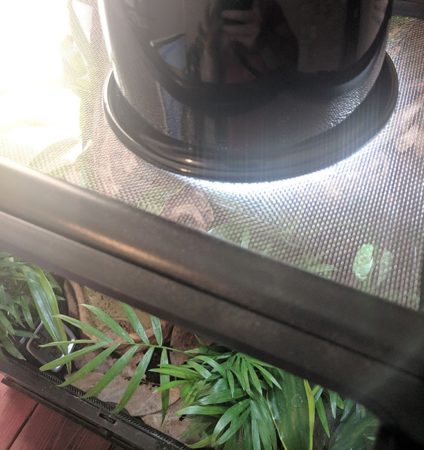
By the way, there are lamp stands made specifically for reptile and amphibian enclosures. I personally haven’t tested it but the Blue Spotted Deluxe Lamp Stand looks like the most reliable one. It has a base that slides under the terrarium.
Anyway, that’s all for this post. I do hope this information was helpful to you. If you have any questions, feel free to ask in the comment section below.

26 Comments
I have two juvie dumpy frogs and I have a uvb for the plants in the tank but they literally love to sit directly under the uvb at the top of the tank all day until I turn it off at night to feed. There was a little lip at the tip of the tank that they would squish themselves in but it made me uncomfortable so I moved a mushroom ledge to the top which they seem to like. I just want to know if them sitting up there in the direct uvb is something normal or are mine just weird.
Studies suggest that amphibians benefit from UVB, especially at the right intensity! I’m curious if you dust their feeder insects with calcium with D3 powder? This is not unheard of!
This artical helped a lot now I am Going to get a UVB light for my green tree frog.
I just got a Australian White Tree Frog, and I have been trying to figure out the best way to “run” the lights. But no where can I find the answers I am looking for. Am I supposed to always have a light on or at night should all lights go off? I keep reading about a light for night time but I have not been able to figure out what that means or if it’s necessary?
Hey! Check out our White’s Tree Frog care guide for some helpful information. As far as the lights go, Get a 5.0 UVB light and leave it on during the day for approximately 12 hours. Say, 7:00 AM until 7:00 PM. Put it on a timer if possible so you won’t forget to turn it off. Don’t use a light during the night time. Their are “night lights” aka “moon lights” but I only recommend using them during the time you’re there watching them. If you’re not watching them, turn it off. Let them rest in darkness. I hope this helps!
Thank you for all the info! My son just got a red-eyed tree frog and I’m trying to help him. Will natural light work instead of the bulb? We got a heater pad… should this go on the bottom or will that heat up his water bowl too much? Or can I put it on the side? Or will that burn him? Or the tank has a styrofoam insert that looks like a rock wall. Can I put the heating pad behind that? Thank you so much!
Hi, Kim! So sorry for the late reply on my part. A heating pad is a good start. It can go on the bottom or side. Make sure not to put it on the side with the styrofoam insert. I’ve never been able to keep my RETF’s enclosure warm enough with a heating pad alone. You may end up having to get a heat lamp. As for the natural light, yes, that is completely fine! Be careful of placing the enclosure next to drafty windows. The light can be helpful but if the drafty window causes the temperature in your frog’s enclosure to drop too much it will do more harm than good.
What type of uvb lighting would you recommend for a pacman frog?
Nothing over a 5 UVB but make sure he has plenty of hiding places away from the light. A hut, plants, etc
Thanks! I also plan on getting a humidifier how long should I let it run? It has a timer
No problem! How long you leave the humidifier on depends on how high you’re trying to get the humidity. That also plays a role in how often it runs. Get a quality thermometer/hygrometer and see how long it takes to raise the humidity to the desired level and go from there!
I just got a tree frog and I am concerned that it is too cold at night but don’t want to use the bright light when he is asleep so what kind should I use when he is sleeping
What type of frog? I recommend reading a reliable care sheet to see what their acceptable temperature range can be at night time. Also, heating pads could be a great solution to warm the enclosure without adding lights.
Hello! I just purchased a white tree frog/ dumpy frog and I got him a 16″L X 16″W X 24.5″H corner terrarium. I’m having so much trouble with the lighting and bulbs and understanding everything that goes with it no matter how much I research, and I haven’t been able to get much help from people I’ve talked to. My apartment stays between 60 and 75 degrees so I was told a heat lamp was unnecessary given that the tank always stays between 70 and 75 degrees, But I’m curious as to how much UBV light is okay for a tank that big. I’m currently using a 13 watt UVB light that gives out 5.0 UVB. Do you have any recommendations for proper lighting?
I would aim for a temperature around 80-85 at the top of the enclosure and 70-75 at the bottom. A 5.0 UVB is perfectly fine but you’ll want plenty of branches and plants to give your frogs hiding places away from the light. The temperate gradient from the top of the enclosure to the bottom is helpful also. The temperate can fall up to 5-10 degrees at night without any issue. Hope this helps
What set up would you recommend for a 30x12x12 enclosure with two Tomato Frogs and what types of live plants would go well with the frogs and the light set up? I have fake plants for now and no light since the frogs are nocturnal, but I would like to upgrade to a day/night light set up and live plants in the future.
Check out this page for help with a tomato frog.
Hi, is it alright to use a low wattage (15 watts) blue moonlight night light for 2 juvenile tiger legged monkey tree frogs?
I’ve used LED moonlights before and they didn’t cause any noticeable problems with my frogs. Here is what I recommend: Use the moonlight to watch your frogs at night but when you’re done watching them, turn the light off.
If your using uvb should you supplement calcium with out d3. I know this is true for reptiles but what about frogs?
I’ve kept up with the supplements even with UVB bulbs. That’s true with reptiles and I’m sure its true with frogs as well but the bulbs I’m using are low UVB.
This is kinda off subject but are you knowledgeable about housing different types of tree frogs together? I have a golden tree frog and wanted to possibly house her with a whites dumpy tree frog of the same size. Do you know if that is possible since they are both types of tree frogs yet different?
I haven’t housed different frogs together myself and most keepers don’t do this. I’ve heard of people doing this successfully (on forums, not in person) but I don’t recommend it. Part of the reason is due to their different toxins. You’ve probably heard of poison-dart frogs, right? They secrete poisonous toxins. Other frogs secrete toxins too, they’re just not as potent. Most frog’s toxins aren’t detectable to humans but they can be harmful to smaller animals – such as other species of frogs. This is one of the reasons a lot of frog owner’s keep their frogs separate.
I have a very small gal tank I bought just for frogs is this big wenoiugh for 2 frogs
Thank you so much for your site and excellent helpful information Sincerely Michael
You’re very welcome! Thanks for the kind comment!